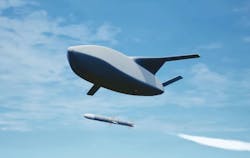Air Force asks industry for future autonomous fighter aircraft and sensors able to shoot down enemy planes
ROME, N.Y. – U.S. Air force experts are reaching out to industry to find companies interested in developing an autonomous aircraft able to detect, track, and shoot down enemy piloted and uncrewed airplanes as large as single-aisle passenger jets.
Officials of the Air Force Research Laboratory Information Directorate in Rome, N.Y., issued a request for information (RFI-RIKD-22-03) on Friday for the Low Collateral Effects Interceptor (LCEI) unmanned aerial vehicle (UAV) project.
The LCEI should be autonomous aircraft, avionics, and sensors with hard-kill systems effective against groups 1, 2, and smaller group 3 aircraft. These types of aircraft range from as small as a six-seat twin-engine general-aviation aircraft to as large as a Boeing 737 passenger jet.
Responses from this RFI is to help Air Force researchers plan for a possible future acquisition strategy and solicitation that could be issued as early as next year.
Testing of such an autonomous fighter aircraft will require the contractor to integrate the test aircraft with ground sensors and truth data systems. The Government will provide red team targets, a test range, logistics support, and data collection at the initial flight assessment.
Initial flight tests will involve responding to scenarios designed to mimic operational incidents, as well as stress test the systems’ engagement speeds, ranges, and endurance. The test aircraft must be based on U.S. components and electronics.
From industry, Air Force researchers want information about candidate test aircraft such as sprint speed; top engagement speed; maximum range; maximum loiter time; size, weight, power consumption, and cost; required number of operators; required training of operators; resistance to shock, dirt, water, and temperature; operational weather limitations; ability to operate at night; multiple target engagements; engagement success rate by target type; engagement success rate by engagement speed; and engagement success rate by altitude.
Related: Experts: advanced sensors are key enablers for fighting UAVs of the future
Researchers also want an overview of candidate aircraft facilities, space, and power requirements; multi-mission capability; system architecture diagram; system maturity; manufacturing maturity; dependencies on external sensors; required external systems; system autonomy for administering kinetic effects; and ground station requirements.
Responding companies also should provide information about aircraft performance specifications; and the kinds of unmanned aircraft these systems have been able to defeat and under what conditions.
Companies interested should email 10-page white papers no later than 8 July 2022 to the Air Force's Matthew Zawisza at [email protected], and Justin Furney at [email protected].
More information is online at https://sam.gov/opp/93083b68ca8e41fbbabb9101781c4695/view.
About the Author
John Keller
Editor-in-Chief
John Keller is the Editor-in-Chief, Military & Aerospace Electronics Magazine--provides extensive coverage and analysis of enabling electronics and optoelectronic technologies in military, space and commercial aviation applications. John has been a member of the Military & Aerospace Electronics staff since 1989 and chief editor since 1995.
